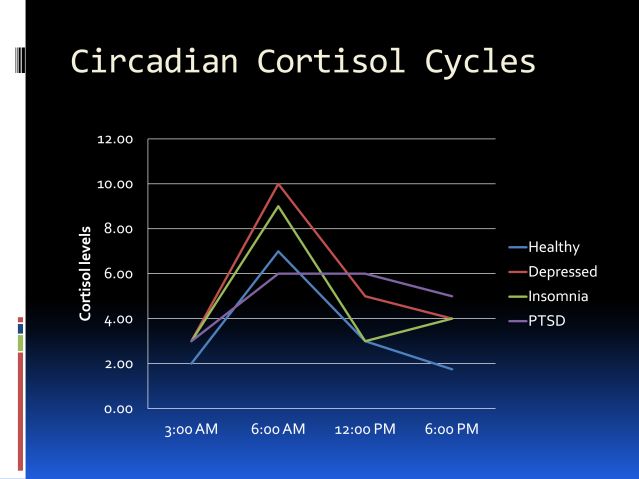Hormones
3 Dimensions of Cortisol Management
Why your health and happiness depend on cortisol.
Posted April 18, 2023 Reviewed by Ekua Hagan
Key points
- Cortisol is an important hormone involved in stress, inflammation, energy regulation, and cognitive function.
- Cortisol naturally follows a circadian cycle. When the cortisol cycle is disrupted, so are its functions.
- The most effective tools for cortisol regulation are sleep, exercise, nutrition, and stress management.
What makes the human body so miraculous? Is it our comparatively large brain? Our versatile muscle system? Our exquisite vision and opposable thumbs? Although all these features are undeniably extraordinary and essential to our capabilities, a powerful but unseen set of chemicals is what ultimately harmonizes these separate attributes to enable human life and performance: hormones.
Hormones are commonly thought of as chemical messengers. But they do so much more. Produced by the brain, organs, bones, muscles, and even by individual cells, your body is populated by over 50 distinct hormones, each one exerting effects independently and well as in concert with others. What are the functions of these hormones? Physical growth (growth hormone). Reproduction (testosterone and estrogens). Metabolic rate (thyroid). Sleep-wake cycle (melatonin). Energy storage and access (insulin and glucagon). Name an important function anywhere in the human body and hormones are probably directing the operation.
Yet even among your diverse family of hormones, there are hierarchies of influence. One subset of hormones is so potent and pervasive across different areas of human function that it can even overrule and countermand the effects of other hormones when necessary to dictate vital biological processes. The most well-known of these hormonal generals is cortisol.
Understanding cortisol
Produced by your two adrenal glands—one sits atop each of your kidneys—cortisol is technically a "steroid" hormone like testosterone and estrogen. (This is why people receiving cortisol treatments often see them labeled as "corticosteroids") Here are some of the most important effects of cortisol:
- Cortisol helps maintain normal blood glucose levels, including overriding insulin when needed.
- Cortisol has powerful anti-inflammatory properties. (Reduced inflammation is the primary benefit of cortisol injections given by doctors for pain and injuries.)
- Cortisol is important to memory formation, especially the formation of emotional memories.
- Cortisol has strong effects on mood, including potent antidepressant effects when present in healthy patterns (more on this below).
- Cortisol is the body's primary stress hormone. Cortisol levels rise in response to both physical and emotional stress, with systemic effects across the brain and body1.
Ask most people about cortisol and only the last of these functions—stress—is likely to be recognized. And cortisol-stress associations are almost always described negatively. In our modern self-help and social media cultures, for example, excess cortisol is often portrayed as being a primary villain in stress and mental illness, with much attention given to products and strategies for reducing cortisol levels. Whether it is plant-based diets, exercise, meditation2, ashwagandha (a recently popular herbal supplement), or even physical touch (hugs may lower cortisol, at least in women3), one of the most commonly cited benefits of each is reducing cortisol.
For the person committed to a higher quality of life, however, including improved physical and mental health, the mainstream messaging about cortisol is unlikely to be helpful. Simply lowering cortisol levels in the body, in fact, is as likely to be harmful as beneficial.
Instead, it is important to consider that cortisol is either beneficial or detrimental depending on three dimensions: timing, duration, and magnitude. The figure below illustrates how these three dimensions come together to either optimize health or predispose illness.

Cortisol timing refers to its circadian pattern across the 24-hour day. Most hormones follow circadian patterns—being relatively higher or lower at certain times of day and night—and correct timing is critical to cortisol benefits. Under healthy circumstances (see the blue line in the figure above) cortisol levels begin rising shortly before we awake and stay moderately elevated for several hours to promote alertness and energy early in the day. When cortisol timing is disrupted—by factors such as poor sleep and mental health conditions—energy, sleep, cognitive function, and mood can become compromised.
Cortisol duration refers to how long the hormone is activated. Ideally, the morning cortisol rise is not only timed correctly to coincide with early day activities, but the elevation also lasts for several hours before gradually lowering. Subsequently, cortisol elevations across the remainder of the day should be brief (e.g., exercise, managing acute stressors) and infrequent.
Cortisol magnitude, finally, refers to how much cortisol is released into circulation. This is the dimension of cortisol that receives almost all the media attention but it is no more important than either timing or duration. Optimal cortisol magnitude is the hormonal equivalent of Goldilocks' porridge: Either too much or too little is detrimental.
Note from the figure above that mental health conditions can't be simply characterized by excess cortisol magnitude: In depression, for example, cortisol timing and duration are also often misaligned. For this reason, just lowering cortisol may or may not have any mood benefits for a person suffering from depression. The cortisol-PTSD relationship is even more counterintuitive: as shown in the above figure, people with PTSD often have lower overall cortisol levels, with concurrent distortions in timing and duration. Once again, simply lowering cortisol in a person with PTSD could unintentionally make their symptoms worse.
How to more effectively regulate cortisol
Now that you understand that hormones like cortisol work along not one but three dimensions—timing, duration, and magnitude—you can more intelligently apply cortisol management strategies to improve health and well-being. In practice, this means that efforts to regulate cortisol require personalized strategies to improve different dimensions. How can this be done?

Cortisol timing—The best ways to correct misaligned cortisol timing—resetting the circadian rhythm of cortisol—is to practice a regular sleep-wake schedule (going to bed and arising at the same time, including on weekends) and obtain early morning sunlight or equivalent light therapy4.
Cortisol duration—Improving cortisol duration can be achieved through multiple cognitive-behavioral strategies. Cognitively, mindfulness techniques and reducing rumination about negative events can both help cortisol levels return to normal after stress. Behaviorally, meditation, regulating exercise time and intensity factors (longer workouts increase cortisol, as does too much exercise intensity), reducing sources of chronic stress, relaxation, and related self-care activities can all help turn off the cortisol release signal and initiate stress recovery mechanisms.
Cortisol magnitude—Helping your body produce the right amounts of cortisol also comes down to using the right cognitive-behavioral strategies. Improving sleep duration and quality (independent of your sleep schedule), consuming higher-quality nutrition (the building blocks for making cortisol), regular exercise and healthy body fat levels (both reduce inflammation, a driver of chronically elevated cortisol), stress management techniques, and minimizing consumption of alcohol are among the most robust approaches for optimizing cortisol levels.
Summary
Cortisol is among the most important hormones in your body. It is also perhaps the most mischaracterized and misunderstood. By understanding the three distinct dimensions of cortisol function, you become capable of applying cognitive, behavioral, nutrition, and supplement approaches to cortisol regulation with greater strategy and specificity. Better health, wellness, and function are the likely result.
References
1. Russell, G., Lightman, S. The human stress response. Nat Rev Endocrinol 15, 525–534 (2019). https://doi.org/10.1038/s41574-019-0228-0
2. Adam Koncz, Zsolt Demetrovics & Zsofia K. Takacs (2021) Meditation interventions efficiently reduce cortisol levels of at-risk samples: a meta-analysis, Health Psychology Review, 15:1, 56-84, DOI: 10.1080/17437199.2020.1760727
3. Berretz G, Cebula C, Wortelmann BM, Papadopoulou P, Wolf OT, Ocklenburg S, Packheiser J. Romantic partner embraces reduce cortisol release after acute stress induction in women but not in men. PLoS One. 2022 May 18;17(5):e0266887. doi: 10.1371/journal.pone.0266887.
4. Ishida A, Mutoh T, Ueyama T, Bando H, Masubuchi S, Nakahara D, Tsujimoto G, Okamura H. Light activates the adrenal gland: timing of gene expression and glucocorticoid release. Cell Metab. 2005 Nov;2(5):297-307. doi: 10.1016/j.cmet.2005.09.009.




